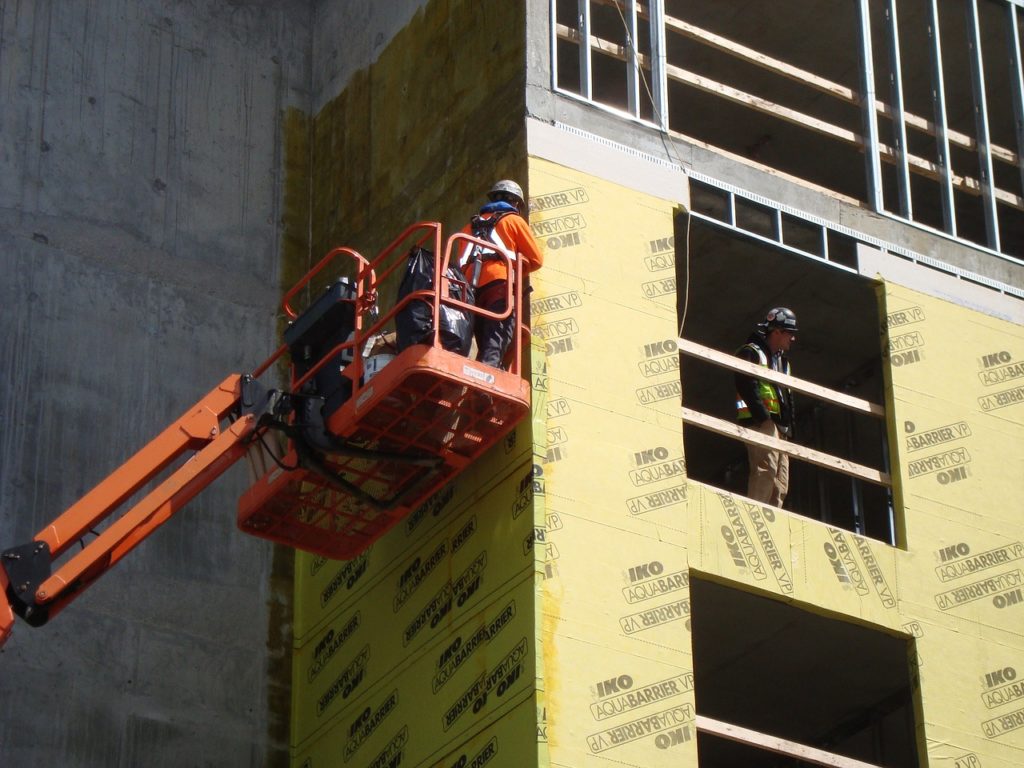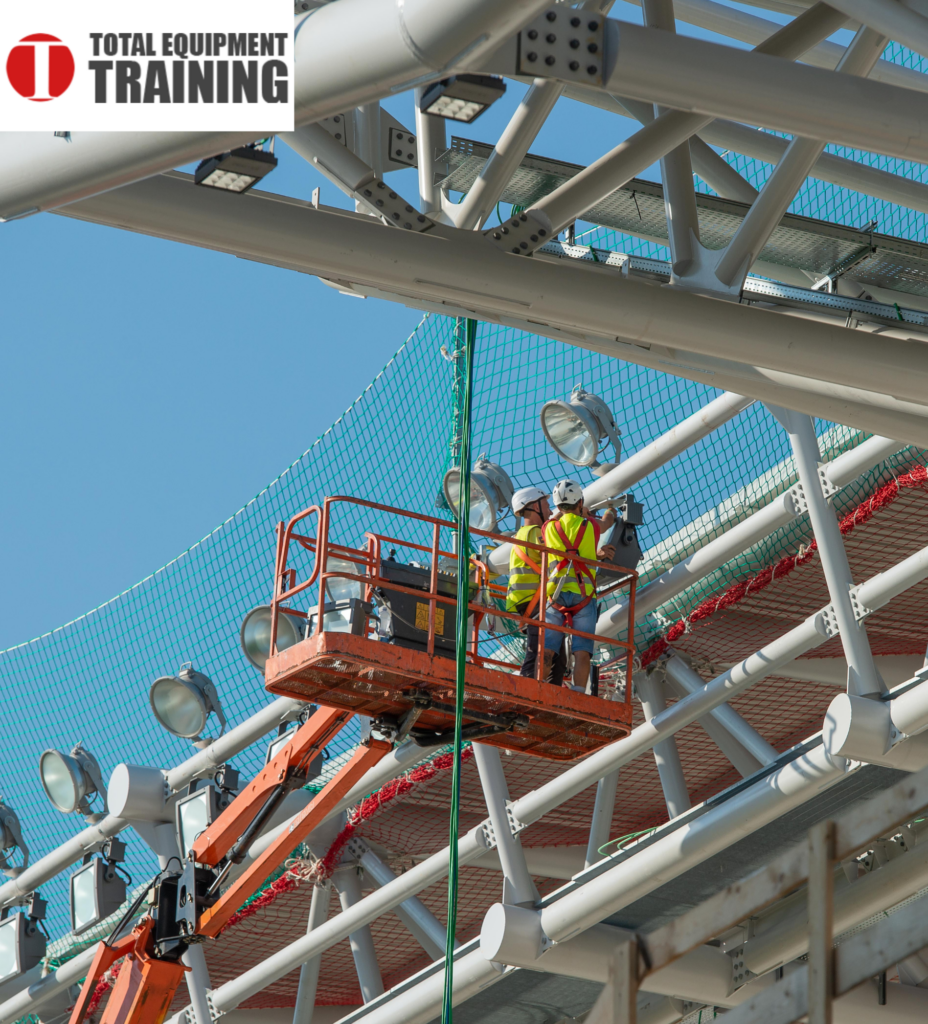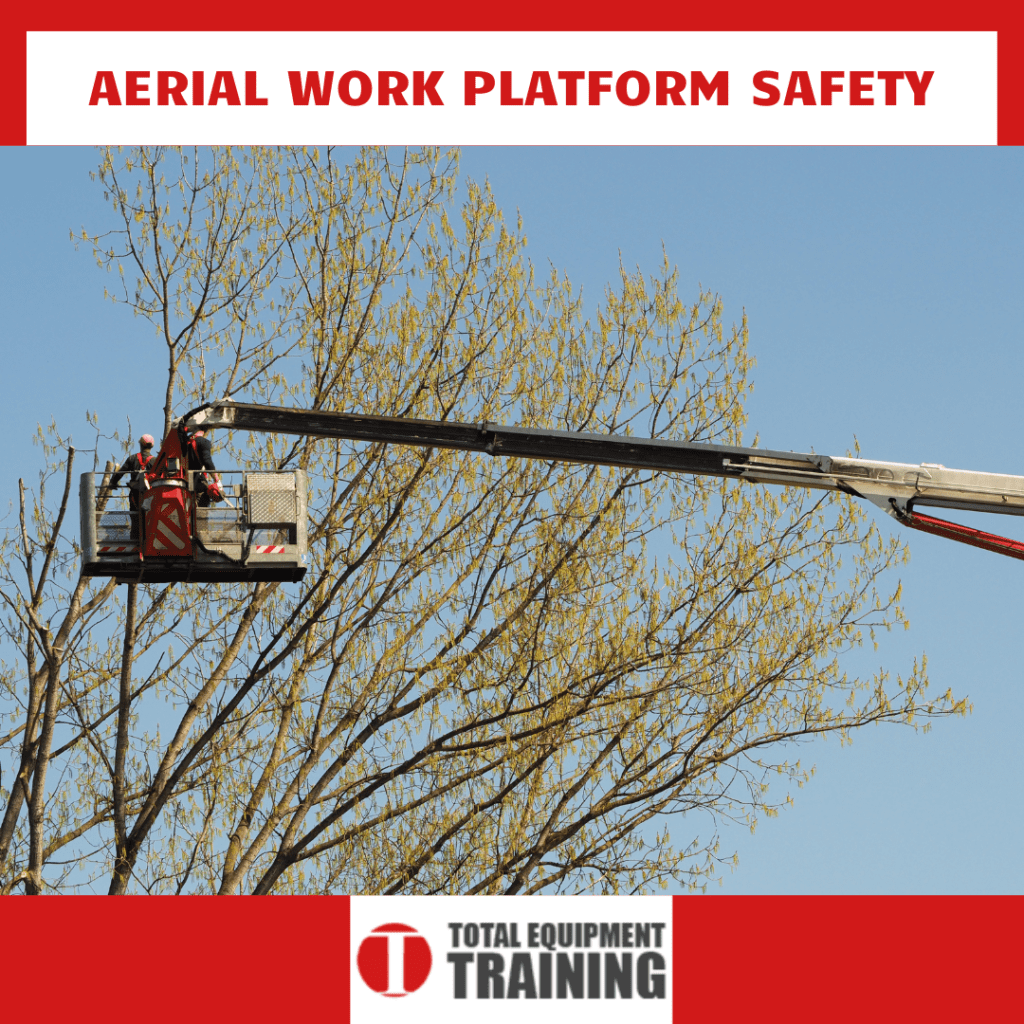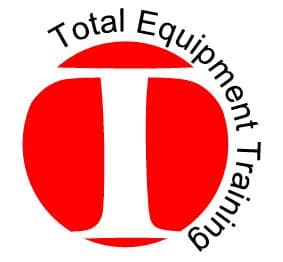Aerial lifts, also known as aerial work platforms (AWPs) or mobile elevated work platforms (MEWPs), are essential tools on construction sites, warehouses, and in various industrial applications. These versatile machines elevate personnel and equipment to otherwise inaccessible heights, offering a safer and often more efficient alternative to traditional ladders and scaffolding.
However, the operation of aerial lifts is subject to stringent safety regulations and training requirements to prevent accidents and ensure the well-being of workers. This comprehensive guide will address key questions about aerial lifts, their uses, the different types available, and the crucial OSHA training requirements for their safe operation.
But with their widespread use comes the responsibility to operate them safely. That’s where OSHA-compliant aerial lift training comes in.
This comprehensive guide will walk you through the types of aerial lifts, OSHA training requirements, ANSI safety updates, common hazards, and best practices for aerial work platform safety.

Table of Contents
- What is an Aerial Lift or Aerial Work Platform?
- Common Types of Aerial Lifts
- What Are Aerial Lifts Used For?
- Who is Allowed to Operate an Aerial Lift?
- OSHA Aerial Lift Training Requirements
- Aerial Work Platform Safety
- Aerial Lift Inspections
- What Happens If an AWP Incident Occurs?
- What Are MEWPs?
- MEWP Training at Total Equipment Training
What is an Aerial Lift or Aerial Work Platform?
An aerial lift is a vehicle-mounted device used to elevate personnel and materials to elevated or hard-to-reach areas on a job site. These machines consist of a mobile base, extendable boom or lifting arm, and a platform or bucket where workers stand.
Given their critical role in various industries, proper training on different aerial lift types is essential for operator safety and job site efficiency, which Total Equipment Training delivers directly to your location. Ensure your team operates these essential aerial lifts safely and efficiently with our comprehensive onsite heavy equipment training programs.
Common Types of Aerial Lifts
Each type of MEWP has unique features suited for specific tasks—from construction and electrical work to retail inventory handling and landscaping.
-
Scissor Lifts
-
- These lifts feature a platform that raises and lowers vertically, directly above the base, using a crisscrossing mechanism. They offer exceptional stability and are ideal for tasks requiring a stable work platform at moderate heights. They provide a more reliable reach and greater carrying capacity than ladders or scaffolding for direct vertical access.
-
Boom Lifts
-
- Similar to scissor lifts but with the ability to reach greater heights and maneuver around obstacles more effectively. They consist of a base and a lifting system that powers a crane-like boom arm with a platform or bucket at the end. Boom lifts can be mounted on trucks or vans for easy transport.
- Articulating (Jointed) Boom Lifts: Feature boom arms with multiple joints or “knuckles” that allow for greater flexibility in reaching over and around obstacles.
- Telescopic Boom Lifts: Have boom arms that extend telescopically, providing the longest reach capabilities among aerial lifts, both vertically and horizontally.
-
Telehandlers
-
- These machines are essentially rough-terrain forklifts with an extendable boom, offering flexible reach capabilities. They are commonly used in agriculture and construction for lifting and placing materials at height and can often be fitted with various attachments beyond just forks, such as buckets or platforms, further expanding their versatility.
-
Spider Lifts
-
- Spider lifts, also known as compact crawler lifts, are characterized by their multiple outriggers that extend outwards and downwards, resembling spider legs. This design provides exceptional stability on uneven or restricted terrain, making them ideal for indoor use (due to their compact size and non-marking tracks) and outdoor applications where space is limited or ground conditions are challenging. Their lightweight construction and maneuverability allow them to access tight spaces that larger aerial lifts cannot reach, often featuring both electric and combustion engine options for versatility.
-
Cherry Pickers
-
- The term “cherry picker” traditionally refers to a type of boom lift, often vehicle-mounted, that was initially designed for orchard work, specifically picking fruit like cherries. Today, the term is often used more broadly to describe smaller, truck-mounted or self-propelled boom lifts with a bucket at the end. They are commonly used for tasks requiring moderate height access, such as utility work, sign maintenance, and window cleaning. Their primary advantage lies in their mobility and ease of transport between different work locations.
Understanding these differences is crucial for selecting the right aerial lift for the job, ensuring both efficiency and safety.
What Are Aerial Lifts Used For?
Aerial lifts are used across a wide range of industries and tasks, including:
- Electrical and Energy: Maintenance and repair of power lines, wind turbines, and other high-reaching infrastructure.
- Retail or Warehouses: Stocking shelves, maintenance of high fixtures, and order picking in large storage facilities.
- Demolition: Safely accessing and dismantling structures.
- Construction: Various tasks such as painting, welding, installing utilities, and general access to elevated work areas.
- Agriculture and Landscaping: Pruning trees, harvesting fruit, and maintaining tall structures.
- Roofing: Providing safe access to roofs for inspection, repair, and installation.
Aerial bucket lifts, a specific type of aerial lift, are particularly versatile due to their 360-degree movement capabilities. They are designed to raise workers and their equipment. Two main types of bucket lifts exist:
- Non-Propelled Bucket Lifts: Typically lighter and more compact, often requiring towing or transport on a flatbed truck. Their smaller size allows them to fit through standard door frames.
- Typical Features: Easy to transport, fits through door frames, lightweight.
- Vehicle-Mounted Bucket Lifts: Feature a compact body and heavy-duty tires for maneuverability in various terrains. Controls located in the aerial work platform allow the operator to move the lift while working.
- Typical Features: More petite and flexible, controllable from the bucket, can reach taller workspaces.
Who is Allowed to Operate an Aerial Lift?
OSHA regulations clearly state that only trained personnel are permitted to operate aerial lifts. According to 29 CFR 1910.67(c)(2)(ii), this is a fundamental requirement, although the specific details and frequency of training are not exhaustively outlined.
In the construction industry, OSHA further mandates that only authorized workers can operate aerial lifts. An authorized person is defined as an individual approved or assigned by the employer to perform a specific duty or be present at a designated location on the job site. Ultimately, the responsibility for ensuring that only trained and authorized individuals operate aerial lifts lies with the employer.
OSHA Aerial Lift Training Requirements
OSHA’s primary requirement is that individuals operating aerial lifts must be trained and authorized by their employer. This training is crucial for equipping operators with the necessary knowledge and skills to operate aerial lifts safely. Key elements that must be covered in OSHA-compliant aerial lift training include:
- Demonstration of Operational Skills: Operators must demonstrate their ability to safely operate the specific type of aerial lift they will be using before being allowed to operate it independently.
- Hazard Identification and Avoidance: Training must cover potential electrical hazards and the risks associated with falling objects, as well as how to recognize and avoid other unsafe conditions in the work environment.
- Proper Operating Procedures: Operators need thorough instruction on the correct operation of the lift, including understanding the maximum intended load and the equipment’s load capacity.
- Emergency and Hazard Response: Training should cover procedures for dealing with potential hazards encountered during operation.
- Pre-Operation Inspections: Operators must be trained on when and how to perform thorough pre-operation inspections of the aerial lift.
- Manufacturer’s Guidelines: Operators should be familiar with the specific operating requirements, safety guidelines, and maintenance recommendations provided by the lift’s manufacturer.
Retraining is also a crucial aspect of OSHA requirements and is necessary in situations such as:
- When an accident occurs involving an aerial lift.
- When new workplace hazards related to aerial lift use are identified.
- When an operator is assigned to use a different type of aerial lift.
- When an employer observes an employee operating an aerial lift unsafely or improperly.

Aerial Work Platform (AWP) Safety
Beyond the regulatory requirements, prioritizing safety when working with aerial work platforms is paramount. Improper use or setup can lead to serious falls for both workers and materials, resulting in injuries, property damage, and increased costs.
AWP Safety Tips
Operating AWPs comes with inherent risks that workers must be aware of and trained to mitigate:
- Falls from Heights: Workers in the bucket are at risk and must use proper fall protection, such as harnesses attached to the bucket railings. Boom operators must ensure the platform remains level and communicate movements clearly.
- Tipping Over: Extending the boom, especially at angles, shifts the center of gravity. Overloading or exceeding extension limits can cause instability. Operators must be aware of weight and extension limits specified by the manufacturer.
- Electrocution: Contact with power and communication lines is a significant hazard. All lines should be considered live. Power supplies should be shut down in the work area, and workers must use appropriate protective gear.
- Entanglement: Overhead cables can become entangled with the bucket, requiring careful maneuvering and awareness.
- Contact with Other Objects: Colliding with lighting poles, signs, buildings, or ground-level obstacles like circuit boxes can cause damage or falls. Maintaining safe distances is crucial.
Aerial Lift Inspections
OSHA mandates frequent and annual inspections of aerial platforms and equipment to ensure their safe operation. If any failures or issues are identified during either frequent or annual inspections, the aerial work platform must not be put into service until all problems are corrected by a qualified person.
-
Frequent AWP Inspections
These inspections should be conducted according to the manufacturer’s instructions by a qualified person before each work shift. Key items to inspect include:
-
- Proper functioning of emergency lowering mechanisms.
- Smooth and controlled operation of all tasks and controls, including speed and limits of motion.
- Legibility and functionality of all placards, warnings, and control markings.
- Proper operation of lower controls, including provisions for overriding upper controls.
- Visual inspection of structural components, fasteners, pins, shafts, and locking devices.
- Condition of all chain and cable mechanisms.
- Adequate lubrication of moving parts and inspection of filters, hydraulic oil, engine oil, and coolant as specified by the manufacturer.
- Functionality of all emergency and safety devices.
- Any other items specified by the manufacturer.
-
Annual AWP Inspections
Annual inspections for MEWP equipment is more comprehensive. These inspections must:
-
- Occur at least once every 13 months.
- Follow the manufacturer’s maintenance checklist.
- Any issues must be corrected before the lift is returned to service.
What Happens If an AWP Incident Occurs?
In the event of:
- An accident involving an aerial lift
- Observed improper use
- Introduction of a new type of aerial lift
Re-training is required to reinforce best practices and maintain OSHA compliance.
Partnering with Total Equipment Training gives your team the skills to work safely and efficiently. Our OSHA-compliant, onsite aerial lift training programs are led by experienced professionals who customize the training to your site-specific needs.

What Are MEWPs?
The term “Mobile Elevated Work Platforms” (MEWPs) is increasingly used and reflects updated ANSI standards (American National Standards Institute standards) aimed at unifying global standards, improving design, reducing accidents, and ensuring safer use of these machines. In June 2020, ANSI introduced new standards (A92.20, A92.22, and A92.24) that impact how MEWPs are designed, used, and trained on.
Key ANSI Aerial Lift Updates:
- A92.22 – Safe Use: Emphasizes risk assessment by a qualified person, proper MEWP selection for the task, ensuring operator and supervisor familiarity with the equipment, and the requirement for a trained and qualified supervisor to monitor operators.
- A92.24 – Training: Updates training requirements for operators, occupants, and supervisors. Operators must be trained, familiarized, and authorized. Occupants must be aware of hazards and safety procedures and use fall protection. At least one occupant should be trained on basic emergency controls. Supervisors require training on MEWP selection, operator/occupant requirements, hazard identification, and relevant regulations.
- A92.20 – Design: Focuses on improving safety through design changes, including:
- Load Sensing: Prevents platform elevation if overloaded and restricts boom extension beyond load limits.
- Wind Exposure: Requires stability testing, wind indicators, and occupant ratings, while maintaining the 28 mph maximum safe operating wind speed.
- Guardrail Heights: Increased from 39.5 inches to 43.5 inches.
- Stability Testing: Mandates solid or foam-filled tires for stability during elevation; air-filled tires require the MEWP to remain stationary when elevated.
- MEWPs compliant with these new design standards will often feature black and yellow banded tape on the toe-board and counterweight.
These standards aim to reduce accidents and improve safety across all work environments where MEWPs are used.
I am text block. Click edit button to change this text. Lorem ipsum dolor sit amet, consectetur adipiscing elit. Ut elit tellus, luctus nec ullamcorper mattis, pulvinar dapibus leo.
Types of MEWP (Based on New ANSI Standards)
The new ANSI standards reclassify MEWPs into two main groups:
- Group A: MEWPs where the platform moves vertically while staying within the tipping lines of the base. These are generally more stable due to the platform remaining directly above the base. Example: Scissor lifts.
- Group B: MEWPs where the platform can extend beyond the tipping lines of the base. While potentially less stable in certain configurations, they offer greater utility as the base doesn’t need to be repositioned for various overhead tasks. Example: Articulating boom lifts.
MEWP Training at Total Equipment Training
As emphasized by both ANSI and OSHA, comprehensive training for MEWP operators, occupants, and supervisors is essential for safe operation. Total Equipment Training offers onsite OSHA-compliant training programs for companies in need of group training for their employees. This heavy equipment operator company training is delivered by experienced professionals in the construction and heavy equipment industries.
Our training ensures your personnel are up-to-date with the latest safety standards and best practices, reducing risks and promoting a safer work environment. Contact us for a consultation to address your specific training needs and ensure your team operates MEWPs safely and efficiently.

